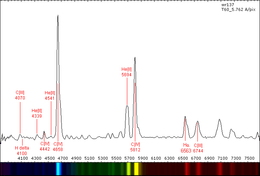WR 137
| Observation data Epoch J2000 Equinox J2000 | |
|---|---|
| Constellation | Cygnus |
| Right ascension | 20h 14m 31.76754s[1] |
| Declination | 36° 39′ 39.6010″[1] |
| Apparent magnitude (V) | 7.91[2] (7.86 - 7.93[3]) |
| Characteristics | |
| Evolutionary stage | Wolf-Rayet |
| Spectral type | WC7pd + O9[4] |
| U−B color index | −0.40[2] |
| B−V color index | +0.29[2] |
| Variable type | WR[5] |
| Astrometry | |
| Proper motion (μ) | RA: −2.986[6] mas/yr Dec.: −5.697[6] mas/yr |
| Parallax (π) | 0.20 ± 0.23[6] mas |
| Distance | 1,820[7] pc |
| Absolute magnitude (MV) | −5.7[7] (−4.52 + −5.25) |
| Orbit[7] | |
| Period (P) | 4,766 ± 66 |
| Semi-major axis (a) | 16 AU |
| Eccentricity (e) | 0.178 ± 0.042 |
| Inclination (i) | 67° |
| Semi-amplitude (K1) (primary) | 27.9 ± 1.2 km/s |
| Semi-amplitude (K2) (secondary) | 6.1 ± 1.3 km/s |
| Details[7] | |
| WR | |
| Mass | 4.4 ± 1.5 M☉ |
| Radius | 10[4] R☉ |
| Luminosity | 537,000[4] L☉ |
| Temperature | 56,000[4] K |
| O | |
| Mass | 20 ± 2 M☉ |
| Age | 4.5[8] Myr |
| Other designations | |
| Database references | |
| SIMBAD | data |

WR 137 is a variable Wolf-Rayet star located around 6,000 light years away from Earth in the constellation of Cygnus.
WR 137, together with WR 134 and WR 135, was one of three stars in Cygnus observed in 1867 to have unusual spectra consisting of intense emission lines rather than the more normal continuum and absorption lines. These were the first members of the class of stars that came to be called Wolf-Rayet stars (WR stars) after Charles Wolf and Georges Rayet who discovered their unusual appearance.[9] It is a member of the carbon sequence of WR stars, indicated by the lack of nitrogen lines and the strength of carbon emission. WR 137 has a spectrum with CIII emission weaker than CIV and OV weaker still, leading to the assignment of a WC7 spectral type. The spectrum also shows emission lines of HeII and OIV.[10][4]
WR 137 is a binary system, with an O9 main sequence or giant companion. The two stars orbit every thirteen years in a mildly eccentric orbit, and there is an episode of dust production near periastron. The inclination of the orbit is uncertain, most likely near 67° but with some analyses suggesting values around 23°.[7] The O star is visually brighter and more massive, but the WR star dominates the spectrum and has a higher bolometric luminosity.
WR 137 is about a degree away from WR 135 and the two are believed to lie at approximately the same distance from Earth within the Cygnus OB3 association.[11] Its properties are uncertain because of the presence of the hot luminous companion. A pseudo-fit of the combined spectrum yielded a temperature of 56,000 K, a luminosity of 537,000 L☉, and a radius of 10 R☉. A more typical radius for a WC7 star would be 4.5 R☉, implying a hotter temperature.[7]
References
- 1 2 Van Leeuwen, F. (2007). "Validation of the new Hipparcos reduction". Astronomy and Astrophysics. 474 (2): 653. arXiv:0708.1752. Bibcode:2007A&A...474..653V. doi:10.1051/0004-6361:20078357.
- 1 2 3 Ducati, J. R. (2002). "VizieR Online Data Catalog: Catalogue of Stellar Photometry in Johnson's 11-color system". CDS/ADC Collection of Electronic Catalogues. 2237. Bibcode:2002yCat.2237....0D.
- ↑ Alfonso-Garzón, J.; Domingo, A.; Mas-Hesse, J. M.; Giménez, A. (2012). "The first INTEGRAL-OMC catalogue of optically variable sources". Astronomy & Astrophysics. 548: A79. arXiv:1210.0821. Bibcode:2012A&A...548A..79A. doi:10.1051/0004-6361/201220095.
- 1 2 3 4 5 Sander, A.; Hamann, W.-R.; Todt, H. (2012). "The Galactic WC stars. Stellar parameters from spectral analyses indicate a new evolutionary sequence". Astronomy & Astrophysics. 540: A144. arXiv:1201.6354. Bibcode:2012A&A...540A.144S. doi:10.1051/0004-6361/201117830.
- ↑ Samus, N. N.; Durlevich, O. V.; et al. (2009). "VizieR Online Data Catalog: General Catalogue of Variable Stars (Samus+ 2007-2013)". VizieR On-line Data Catalog: B/gcvs. Originally published in: 2009yCat....102025S. 1. Bibcode:2009yCat....102025S.
- 1 2 3 Gaia Collaboration (2016). "VizieR Online Data Catalog: Gaia DR1 (Gaia Collaboration, 2016)". VizieR On-line Data Catalog: I/337. Originally published in: Astron. Astrophys. 1337. Bibcode:2016yCat.1337....0G.
- 1 2 3 4 5 6 Lefèvre, L.; Marchenko, S. V.; Lépine, S.; Moffat, A. F. J.; Acker, A.; Harries, T. J.; Annuk, K.; Bohlender, D. A.; Demers, H.; Grosdidier, Y.; Hill, G. M.; Morrison, N. D.; Knauth, D. C.; Skalkowski, G.; Viti, S. (2005). "Spectroscopic study of the long-period dust-producing WC7pd+O9 binary HD192641". Monthly Notices of the Royal Astronomical Society. 360: 141. arXiv:astro-ph/0504475. Bibcode:2005MNRAS.360..141L. doi:10.1111/j.1365-2966.2005.09017.x.
- ↑ Smith, L. F.; Meynet, G.; Mermilliod, J.-C. (1994). "Improved bolometric corrections for WR stars from cluster membership and evolutionary models". Astronomy and Astrophysics. 287: 835. Bibcode:1994A&A...287..835S.
- ↑ Murdin, P. (2001). "Wolf, Charles J E (1827-1918)". The Encyclopedia of Astronomy and Astrophysics. p. 4101. Bibcode:2000eaa..bookE4101.. doi:10.1888/0333750888/4101. ISBN 0333750888.
- ↑ Hiltner, W. A.; Schild, R. E. (1966). "Spectral Classification of Wolf-Rayet Stars". Astrophysical Journal. 143: 770. Bibcode:1966ApJ...143..770H. doi:10.1086/148556.
- ↑ Gervais, Simon; St-Louis, Nicole (1999). "A Large H I Shell surrounding the Wolf-Rayet Star HD 191765". The Astronomical Journal. 118 (5): 2394. Bibcode:1999AJ....118.2394G. doi:10.1086/301065.
External links
- Wolf-Rayet shells showing a spectrum of WR 135
- WR134 Ring Nebula with WR 135 visible in the top left corner